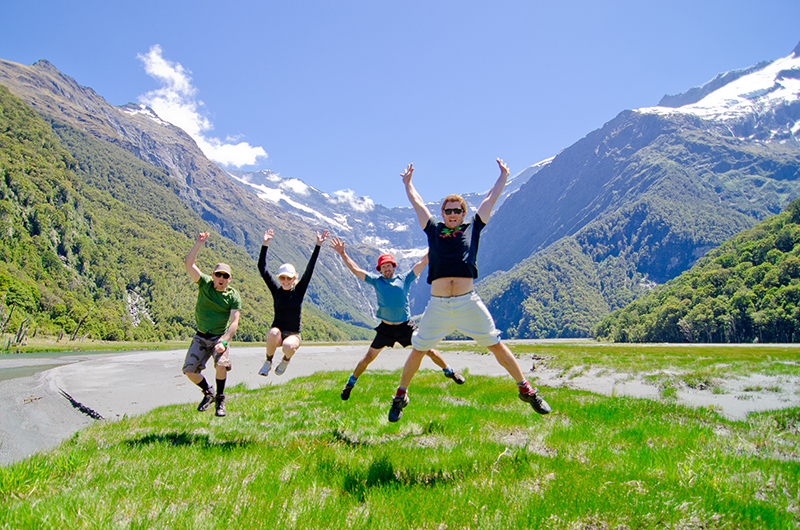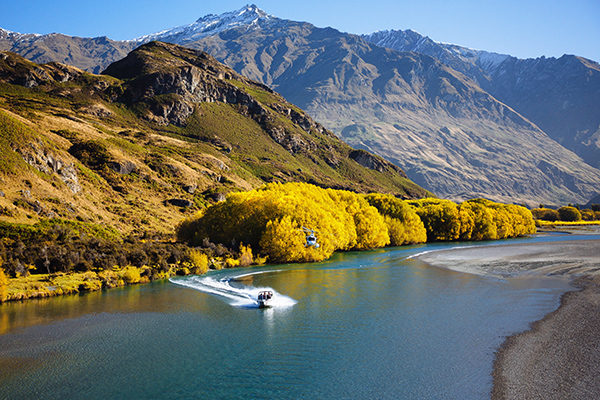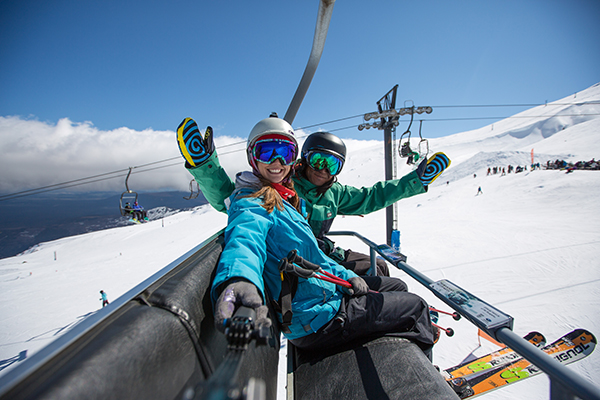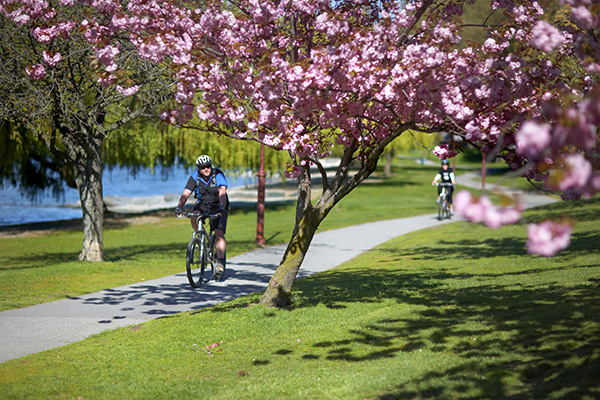Seasonal Guide: What Should You Pack for Your New Zealand Holiday
Are you planning a New Zealand holiday but worrying about luggage allowances? Trying to cover all possible bases with your clothing? Don’t fret! We’ve got all the information you need to make preparing for your NZ trip as easy as possible – and as comfortable as can be once you get here. Just remember, down here in the Southern Hemisphere our seasons run opposite to up North! It’s a fact that can be easily forgotten and there’s nothing worse than being caught in a t shirt when a winter gale comes blowing through town or filling your suitcase with scarves and heavy jeans only to find you never actually wear them on your trip.
New Zealand’s four seasons bring a great variety of weather conditions, from crispy cold Winter wonderlands to sun baked Summers, so it pays to make sure you’re suitably equipped. But don’t be fooled into thinking one season is ‘better’ or more beautiful than the other, because that’s one of NZ’s greatest assets – year-round beauty and attractions! Quiet seasons outside the Summer peak also have their own benefits like cheaper travel costs and lower competition for attraction spots, so you can make yourself at home and take it easy. Here’s how you can make your trip an unforgettable one – whatever the season, there’s a reason to visit Aotearoa…
In the Summertime, When the Weather is Fine

Summer Hikes
When is it?
- The Kiwi Summer runs from December to February.
What’s the weather like?
- Hot! But not suffocating or muggy. Daytime temperatures average 20-25˚C (68-77˚F), rain is relatively uncommon and sunshine hours are long, and get longer the further South you roam!
What do I need to bring?
- Sunscreen: New Zealand’s sun can be intensely powerful and burn times may be quick, so don’t bother with the tanning oil during the middle of the day when the sun is at its hottest… factor 30 and above is recommended.
- T shirts and linen shirts, shorts, light jeans and summer dresses: Summer in New Zealand calls for casual cuts that won’t cling to you as the weather warms up.
- Sandals/Thongs: Down here we call them “jandals”! Perfect for beach days or lounging round the pool.
- Hats: Good for keeping yourself covered on those sunny afternoons.
- Insect Repellent: Sandflies and Mosquitos may hang out near beaches and lakes and can irritate with harmless but itchy bites.
- Swimwear: Also known as “togs” in New Zealand.
- Walking boots/strong shoes: NZ has some legendary day walks and tracks, but they can be challenging so strong shoes are recommended.
What don’t I need to bring?
- Rain jackets or umbrellas: Rain isn’t common in NZ in the summer, and it’s a dry heat compared to the humid climates found in parts of Australia so sweat bands aren’t necessary.
- Lots of heavy clothing, hats, or scarves. A couple of items of warm clothing is always sensible, but generally you won’t have much use for them!
What’s on in Summer?
- Seafood is on the menu 365 days a year, but Summer is perhaps the best time of year to enjoy fish and chips on the beach as the sun sets, or sample local delicacies like crayfish (lobster), scallops and pāua (abalone).
- Pop up stone fruit shops selling peaches, cherries, berries and other seasonal fruit spring up all over New Zealand in the hot season, look out for them!
- Cricket is the Summer game. The national team, the Black Caps play games in all of the major cities and local teams in small towns are abundant, so you’ll get plenty of chances to sit and enjoy a game on the weekend. Beach and backyard cricket (also known as BYC) are also favourite summer pastime for New Zealanders.
Pro Tips?
- Book early to avoid disappointment. Summer is New Zealand’s peak holiday season, and tours, hotels and attractions can book out months in advance, so it pays to be organised to ensure you don’t miss out on your dream itinerary.
Autumn Leaves Are Falling Down

The Shotover River in Autumn
- March to May.
What’s the weather like?
- Cooling off, but still plenty of warmth during the day. Average temperatures in the daytime are 17 – 21˚C (62 – 70˚F). Nights start to get noticeably chillier in April, and rains more frequent, but the days are still long and there’s plenty of sunshine hours.
What do I need to bring?
- Wind resistant and rain resistant clothing: You’ll still want to be exploring, but the weather in Autumn can be changeable and chilly winds or rain showers can whip up unexpectedly, so keep the rain jacket and a scarf handy especially as night draws in.
- Underlayers: Thermals are great ways to keep the bulk down in your luggage while still providing the warmth you may need on a colder day. They’re also easily removed and stored in a bag if the sun comes out to play.
- Jeans and sweaters: The evenings and nights in Autumn can get pretty chilly, but you may still want to spend time outside where warm clothes like woollen sweaters and jeans are perfect.
- Swimwear: March can still be very warm, so don’t rule out a dip in the ocean just because it’s not technically Summer!
- Strong shoes/Walking boots: walking trails can get slippery after rain, especially with fallen leaves on the ground, so bring some footwear with good grip.
- A camera: Of course!
What don’t I need to bring?
- Ski gear: The leaves may be falling and the temperature dropping, but the slopes aren’t open for business just yet.
What’s on in Autumn?
- Beautiful colours: Autumn may be the most beautiful time of year for photography, as the changing colours of the leaves on the trees can make for some really special photographs, particularly with the softer light of Autumn. Central Otago and Hawke’s Bay are especially known for their amazing Autumn colours.
- Peace and quiet! It’s the low season in New Zealand, but that’s a bonus… accommodation, attractions and activities are all readily available and you can enjoy your trip at your own pace and avoid the crowds.
- Hokitika Wild Foods Festival: This famous festival offers a taste of the wild side for adventurous travellers, with quirky culinary delights from Huhu grubs (some say they taste like peanut butter!) and Possum kebabs, to more traditional fare like wild boar and venison.
- Rugby season: Rugby is New Zealand’s national game, and the legendary All Blacks national team start their season in early Autumn, with local teams starting to play as early as February. Early season is a good time to get cheap tickets to a game and see some stars in action while the warm weather is still around.
Pro Tips?
- Travellers on self-drive tours will need to use extra caution on the roads, particularly in rural areas as ice and flooding may be present.
All the Leaves Are Brown, On a Winter’s Day

Skiing in the Winter
- June to August.
What’s the weather like?
- Crisp and cold. Daytime average temperatures are 12 – 16˚C (53 – 61˚F), but the mercury will regularly sink well below 0˚C and into the negatives in many areas, especially mountain regions in the South like Queenstown and Wanaka.
- More Northern regions above Auckland experience much milder Winters than most areas of the country.
What do I need to bring?
- Ski gear! The mountains of Central Otago, Canterbury and Ruapehu are alive with activity and the slopes await you! If you don’t own ski gear, you can hire some on the mountain or in town at any of New Zealand’s ski resorts.
- Layers: Thermals are great for wearing underneath sweaters to ensure you keep warm.
- Waterproof and windproof jackets: Winter winds and rain can be bitterly cold if you’re not prepared, but layers and a good quality jacket will see off even the worst NZ has to offer, it’s not quite Antarctica after all!
- Heavy coats, scarves, socks, woollen hats: This is the time to break out your favourite winter warmers like those thick woollen socks, coats and hats that will ensure you’re toasty even when exploring in snowy conditions.
- Gloves: Cold hands make it hard to enjoy yourself, keep a pair of gloves in a bag or pocket whenever you’re heading out.
- Swimwear: NZ has many natural hot pools, spas and geothermal attractions – bring your “togs”!
- Grippy & strong shoes or boots: Roads and laneways can get icy and slippery in the snowy season, a pair of waterproof boots and shoes with good grip will keep you in good shape.
What don’t I need to bring?
- Shorts.
What’s on in Winter?
- Skiing: It’s the #1 reason for a Winter holiday! Queenstown and Wanaka are buzzing with activity at this time of year, so booking accommodation in advance is recommended.
- Hot Pools: Natural hot pools and spas are abundant in NZ and are a real treat when the temperature drops.
- Queenstown Winter Festival runs every winter and is a highlight, with street parties, fireworks displays, craft markets and festivities on Coronet Peak and the Remarkables ski fields.
- Rugby: Winter is the peak of the rugby season each year and is the best time to get yourself to an All Blacks game.
Pro Tips?
- Travellers booking self-drive holidays may want to plan some guided trips and days off the road to avoid hazardous road conditions.
- Many of the high roads in NZ will be closed under heavy snow and ice at various points in Winter, and it’s a good time to leave the car behind and take advantage of a guided tour.
Spring Vacation, Good Vibrations

Spring in Queenstown
When is it?
- September to November.
What’s the weather like?
- Changeable. Average daytime temperatures are 16 – 19˚C (61 – 66˚F). Spring is known as NZ’s “waterfall season”, due to heavy rainfall in some regions.
- There’s plenty of sunshine on offer, but weather patterns can change quickly, and cold mornings and nights are still common.
What do I need to bring?
- Waterproof jacket – It’s waterfall season in New Zealand and rain can be frequent.
- Layers – T shirts and thermals are great for Spring as they allow you to quickly adapt to the changeable nature of the weather.
- Strong, grippy shoes – Walking trails are calling, and with rains being common you’ll need some shoes that can handle a slippery track.
- Light sweaters and scarves – You’ll want to be able to fend off a chilly wind while wearing lighter layers.
- Sunscreen – NZ’s sun can be burning even on mild or overcast days so be prepared, especially when heading out on long walks.
What don’t I need to bring?
- Lots of heavy, bulky sweaters and coats. They will mostly be a burden to carry around!
What’s on in Spring?
- Spring blossoms and Lupins in Tekapo and the Hawke’s Bay bring the countryside to life with splashes of beautiful purple, blue and yellow flowers. Biking trails are at their best in Spring.
- Walking trails – Enjoy the warmer weather without the crowds of Summer, Spring is our pick as the best time to explore one of New Zealand’s famous walks.
- Food and Wine festivals run each Spring in the Winemaking regions of the North and South Island – check out Toast Martinborough or the Hawke’s Bay Food and Wine Classic.
- Late season skiing – Ski seasons often run deep into Spring, and you can enjoy a day on the mountain with some lighter gear thanks to the warmer temperatures!
- Hobbit Day at Hobbiton – Craft beer, cider and non-alcoholic ginger beer at the iconic movie set, with prizes for the best dressed Hobbits.
- World of Wearable Art Wellington – One of the most unique cultural shows anywhere in the world, with stunning wearable artworks on show.
Pro Tips?
- Spring is the best season for exploring some of the beautiful drives around New Zealand – the roads are quieter than Summer and the stunning blossoms mean rural roads really look their best. A self-drive paradise!
Explore the Land of the Long White Cloud in the rain, sunshine or snow! Get in touch with Relaxing Journeys today and count down the ho
